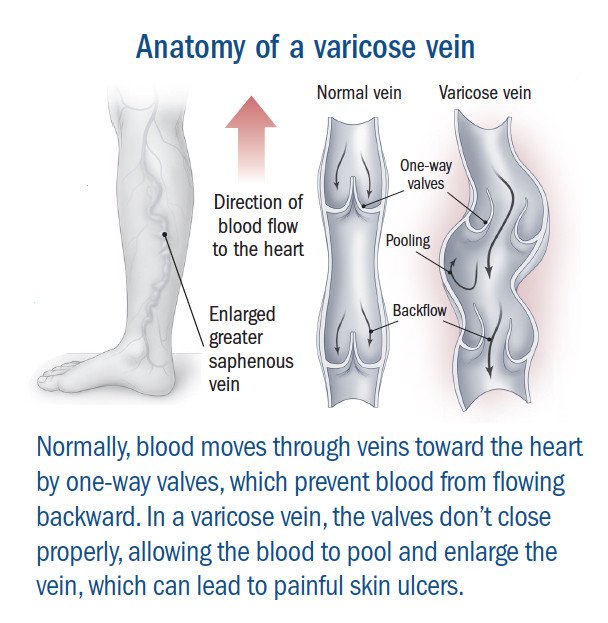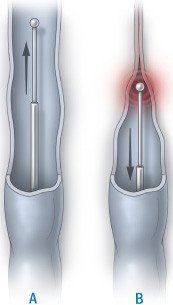Varicose veins
Medically reviewed by Drugs.com. Last updated on Mar 23, 2023.
What are Varicose veins?

Varicose veins occur when veins just below the skin's surface are damaged, become swollen and fill with too much blood.
Veins are the blood vessels that return blood to the heart. Arteries carry blood away from the heart to the rest of the body,
Varicose veins most commonly occur in the legs. In about 50% of cases, the condition runs in families, and probably is related to an inherited weakness in the veins' walls or the valves inside veins that keep blood from backing up.
Pregnancy is another common cause of varicose veins. During pregnancy, the volume of blood increases causing veins to expand. Also, occupations that require uninterrupted standing (waitresses and waiters, nurses, mothers with young children) may force leg veins and valves to work against gravity for hours, increasing the risk of pressure-related vein and valve damage. Garters also can increase the risk of varicose veins if their tight elastics slow blood flow in the legs.
Varicose veins are 2 to 3 times more common in women than men. Obese people are more likely to develop varicose veins.
Varicose veins can be associated with prior blood clots and damage to the deeper veins in one or both legs, a situation that sometimes can lead to chronic venous insufficiency. When this happens, the veins lose their ability to effectively move blood back to the heart. This can cause significant leg swelling and skin sores or ulcers.
Symptoms
In the legs, varicose veins commonly are found along the inside of the leg, at the ankles and at the back of the calf. The affected veins look blue, swollen or stretched out, kinked or twisted.
A dull ache in the legsIn some people, varicose veins do not cause any symptoms. However, other people may experience one or more of the following:
- a feeling of pressure or heaviness in the legs
- swollen feet and ankles
- itching skin near the damaged veins.
In more severe cases of chronic venous insufficiency, a slowing of blood flow through the vein can lead to localized skin changes, including dryness, a rash or brownish discoloration and open sores (ulcers). Slow blood flow also can cause a clot to form inside the affected vein. This condition is called thrombosis.
In general, symptoms of varicose veins are worse at the end of the day, especially after periods of prolonged standing. Some women also find that their symptoms are more intense during the days before their menstrual periods, and during pregnancy.
Diagnosis
Your doctor will ask you about your symptoms and about your family history of varicose veins. He or she also will ask about your lifestyle, especially the number of hours that you spend on your feet. In women, your doctor will ask about your pregnancy history and about the tightness of elastics on the socks or stockings you wear.
Your doctor can diagnose varicose veins with a simple physical examination. In most cases, no special tests are necessary.
Expected duration
Varicose veins are a long-term problem, but symptoms can come and go. If you are pregnant and experiencing severe problems with varicose veins, your symptoms will improve after delivery. However, your varicose veins probably will not disappear totally, and you can expect symptoms to return during future pregnancies.
Prevention
You can help to prevent varicose veins by maintaining a normal weight and by avoiding situations where you must stand for prolonged periods. Even with these preventive measures, however, you still may develop varicose veins if this condition tends to run in your family.
If you already have varicose veins, you can prevent symptom flare-ups by periodically lying down or sitting down with your legs elevated above the level of your chest. Some physicians also recommend that you wear support stockings or more specialized compression stockings when you walk or stand for long periods of time. The stockings prevent blood from pooling in the veins, and prevent strain on the valves and leg swelling.
Treatment
Treatment for most people with mild symptoms of varicose veins includes:
- elevating and supporting the legs periodically throughout the day
- wearing compression stockings.
For varicose veins that are close to the skin, dermatologists or vascular surgeons may offer sclerotherapy or laser therapy. Sclerotherapy involves injection of an irritating into the affected vein, causing the vein to scar and shut down. Laser therapy can be effective for the smallest varicose veins.
People with severe venous insufficiency can develop recurrent blood clots and skin ulcers. The traditional surgery is called vein stripping and ligation. In this surgical procedure, the abnormal veins are tied off and pulled out of the body through series of small cuts in the skin. Another surgical procedure, called ambulatory phlebectomy, also removes veins through small skin incisions, but it is less invasive than classic stripping and ligation.
Newer therapies include endovenous thermal ablation and transilluminated power phlebotomy (a modified form of ambulatory phlebotomy). Endovenous thermal ablation uses laser or high-frequency radio waves to heat the abnormal veins. These newer procedures appear to cause less scarring, with less "down time."
External laser therapy is reserved primarily for cosmetic removal of small, superficial, spider-like veins.
Endovenous treatment
After the varicose vein has been located with ultrasound, a catheter is inserted into the vein (A) through a small opening in the skin. The catheter delivers either laser or radiofrequency energy to the vein wall, heating it and causing the vein to collapse. The vein closes as the catheter is withdrawn (B). |
Treatment options
The following list of medications are related to or used in the treatment of this condition.
When to call a professional
Call your doctor whenever you have pain, swelling, skin ulcers or an unexplained area of bruising on your legs. New leg swelling, especially in just one leg, can be caused by a blood clot, which requires immediate treatment.
If you have varicose veins, call your doctor immediately if you develop an ulcer or a painful, black and blue area near a varicose vein or if you cut the skin over a varicose vein and you have trouble controlling the bleeding.
Prognosis
Varicose veins are a long-term problem, but their symptoms often can be controlled with leg elevation and therapeutic stockings.
Surgical procedures remove varicose veins permanently, but they leave scars, and they cannot prevent new varicose veins from forming.
Additional info
National Heart, Lung, and Blood Institute (NHLBI)
https://www.nhlbi.nih.gov/
American College of Surgeons (ACS)
https://www.facs.org/
Learn more about Varicose veins
Treatment options
Care guides
Further information
Always consult your healthcare provider to ensure the information displayed on this page applies to your personal circumstances.

